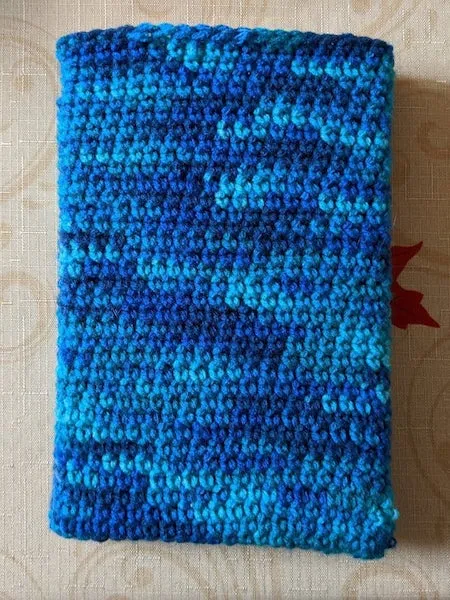
How to Make (or Buy) Your Own Crochet Book Sleeve
This content contains affiliate links. When you buy through these links, we may earn an affiliate commission.
We’ve all done it: tossed a book in our bag while we were in a hurry, then opened it up later to discover that some implement or other had worked its way between the pages, bending them or even tearing them—the horror! The bookmark has perhaps fallen out, and you’re kicking yourself because you know better. Enter the crochet book sleeve: a cover-and-page saving device that can double as the jumpstart you’ve been looking for to get you (or your kids) into a textile craft, should you be so inclined.
Crochet is a handcraft with nebulous origins. At its core, it is linked knotwork, different from knitting and weaving, which are much more flat. It creates a thicker, more 3-dimensional fabric that is perfect for our purposes, as we want a sturdy book sleeve that can withstand a bit of banging around. It is also generally quicker to work up (“quicker” being a relative term if you’re very new to handcrafts, but stay with me here). If you’d like to make your own crochet book sleeve, read on! And if you’re more inclined to support an independent textile artist who has done the handiwork already, I’ve listed several options as jumping-off points on Etsy at the bottom of this article.
How To Make a Crochet Book Sleeve
To begin, you’ll need three things: a crochet book sleeve pattern, basic crochet instructions, and materials.Crochet Book Sleeve Pattern
I did some digging and found this excellent and modifiable pattern from YARNutopia, designed to hold a typical hardback. The designer, Nadia Fuad, also has a 22-minute video that walks through the creation of her crochet book sleeve step-by-step. As a novice hooker, I feel pretty confident that I could follow along with her instructions. One note that I do have is: count your stitches! Otherwise you’ll end up with a lamp cozy instead of a book sleeve. Still useful (?), but not exactly what we’re going for today.Basic Crochet Instructions
I taught myself to knit in 2007 using the internet. Just up and decided one day that, despite my both of grandmothers trying for many years to pass along this skill, I was going to learn it by myself. I have not, to this day, learned to crochet very well. That might change now that my friend Lindsey at Stilly River Yarns sent me her favorite how-to-crochet blog, Moogly. This blog has several short videos that show each crochet stitch. The advantage is that you can watch each video as many times as it takes for you to understand the mechanics of each stitch. As a visual learner, I find this extremely helpful. It’s a bonus that a video can’t sigh with frustration when you say “wait, can you show me that again?” for the 57th time, unlike my grandmothers. Bless them and their patience. If you prefer to learn from a book, we have you covered with Cassandra’s list of 25 of the Best, Most Fun, and Super Useful Crochet Books.Materials
Nadia gives a list of materials for the crochet book sleeve in her pattern, linked above. It’s also a good set of materials for getting started with crochet in general. Below, I’ve further simplified Nadia’s list with a few notes of my own.- A worsted weight yarn with at least 200 yards.
- I recommend acrylic for this (not wool or silk or cotton). It’s going to bang around in your bag, after all, so it needs to be bomb-proof and preferably washable. Lion Brand or Red Heart are excellent starting points.
- Choose something solid colored on the lighter end of the color spectrum. Also, steer away from yarn with a lot of texture while you’re learning. Smooth yarn makes it easier to count and to see the structure of the stitches.
- I find these to be economical and more comfortable than the plain straight ones.
- Always more expensive than you want them to be and almost as mysterious as bobby pins in their ability to disappear at will, but invaluable when you need one—which is at the end of every project.
- If you’re planning to continue your crochet journey, I do recommend investing in dedicated stitch markers. Just make sure they can be opened like the examples linked above.
Crochet Book Sleeves You Can Buy
Perhaps you don’t fancy making your own crochet book sleeve, or you’d rather start with a crochet bookmark, but you also want a handmade book sleeve because handmade things are cool and support textile artists. Etsy has your back! A charming blue Book Sleeve from Bridget’s Crochet Creations.
A charming blue Book Sleeve from Bridget’s Crochet Creations.
 A snazzy striped Book Sleeve from MadeWithHooks.
Finally, you can search for “crochet book sleeve” and see what comes up!
A snazzy striped Book Sleeve from MadeWithHooks.
Finally, you can search for “crochet book sleeve” and see what comes up!





